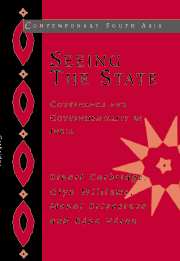Book contents
- Frontmatter
- Contents
- List of boxes, figures and tables
- Acknowledgements
- Glossary
- List of abbreviations
- Introduction
- Part I The state and the poor
- 1 Seeing the state
- 2 Technologies of rule and the war on poverty
- Part II The everyday state and society
- Part III The poor and the state
- Appendix 1 Major national programmes and policies related to poverty alleviation, 1999
- Appendix 2 The 1999 general election in Hajipur
- References
- Index
1 - Seeing the state
Published online by Cambridge University Press: 22 September 2009
- Frontmatter
- Contents
- List of boxes, figures and tables
- Acknowledgements
- Glossary
- List of abbreviations
- Introduction
- Part I The state and the poor
- 1 Seeing the state
- 2 Technologies of rule and the war on poverty
- Part II The everyday state and society
- Part III The poor and the state
- Appendix 1 Major national programmes and policies related to poverty alleviation, 1999
- Appendix 2 The 1999 general election in Hajipur
- References
- Index
Summary
Introduction
We have said that one aim of this book is to consider how differently placed men and women see the state in rural India. Some of these individuals will be employees of the state, or external advisers to the Government of India and its constituent states and Union territories, although many more will be farmers or labourers. Some will be political fixers and members of the Backward Classes, while others will be farmers, Class IV government servants and adivasis at the same time. But what does it mean to talk about ‘seeing the state’?
We are used to the idea of the state seeing its population or citizenry. Visuality is at the heart of many theories of power and governmentality. Michel Foucault, most notably, has shown how the birth of modern forms of education and welfare provision corresponds to the emergence of biopolitics as a ‘form of politics entailing the administration of the processes of life of populations’ (Dean 1999: 98). Populations emerge when changes in working practices give rise to economic government and the discipline of political economy, and they get bounded by new exercises in mapping and measurement, including the production of censuses, cadastral surveys and expeditions. Biopolitics then refers to those government interventions that seek to improve the quality of a population as a whole, and these procedures produce that which we name the state as the effect of these interventions.
- Type
- Chapter
- Information
- Seeing the StateGovernance and Governmentality in India, pp. 15 - 46Publisher: Cambridge University PressPrint publication year: 2005



